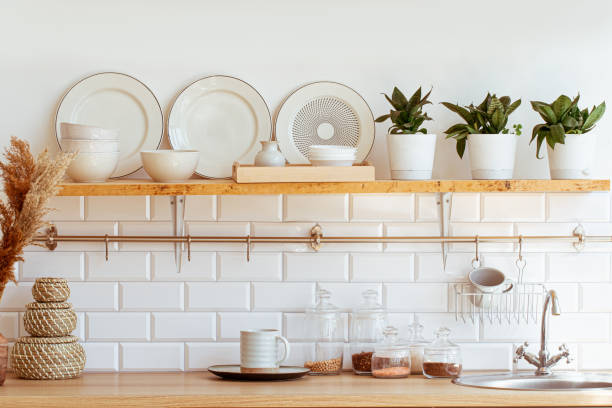Plants to Decorate Kitchen Cabinet Tops

Adding plants to the top of your kitchen cabinets can infuse life and freshness into your space. The right plants can creatively fill the unused space above your cabinets, turning it into an attractive focal point. This article highlights the best plants to decorate your kitchen cabinet tops, exploring their aesthetic appeal, growing needs, and the benefits they bring to your home.
1. Pothos
Pothos is one of the most popular plants for decorating kitchen cabinet tops. This plant is known for its trailing vines and heart-shaped leaves, which can effortlessly cascade down the side of your cabinets. Its vibrant green foliage adds a touch of nature to your kitchen, and its minimal care requirements make it a favorite among busy homeowners. Pothos thrives in indirect light and can tolerate low-light conditions, making it perfect for kitchens.
2. Snake Plant
If you are looking for a plant that requires very little maintenance, the snake plant is a prime choice. With its upright, sword-like leaves, this plant offers a striking addition to the top of your cabinets. The snake plant is renowned for its air-purifying qualities, helping to remove toxins from the air. It thrives in various lighting conditions, from bright indirect light to low light, and needs infrequent watering, making it ideal for busy settings like the kitchen.
3. String of Pearls
The string of pearls plant is a unique and eye-catching choice for decorating the tops of kitchen cabinets. This succulent features trailing stems adorned with small, spherical leaves that resemble a string of pearls. It adds a whimsical and sophisticated touch to your kitchen decor. This plant prefers bright, indirect light and well-draining soil. Being a succulent, it requires minimal watering, making it a practical choice for those who might occasionally forget to water their plants.

4. Spider Plant
Spider plants are celebrated for their ease of care and their ability to thrive in various environments. Their long, arching, green and white striped leaves spill gracefully over the edges of your cabinets, making them a beautiful addition to your kitchen. They flourish in bright, indirect light but are also tolerant of lower light levels. Spider plants also produce “babies” or offshoots that can be repotted, giving you more plants to decorate with. They are great for purifying the air, enhancing the overall indoor air quality in your kitchen.
5. ZZ Plant
The ZZ plant is another excellent option for those seeking a low-maintenance yet stylish addition to their kitchen cabinet tops. Known for its thick, waxy leaves that shine with a glossy finish, the ZZ plant adds a modern touch to the kitchen. It is highly resilient and can thrive on neglect, making it suitable for any home. The ZZ plant does well in low to bright, indirect light and only needs watering when the soil is completely dry. Its robust nature and appealing aesthetics make it a top contender for kitchen decor.
Conclusion
Decorating the tops of your kitchen cabinets with plants can dramatically enhance your space, bringing in elements of nature and adding visual interest. Choosing the right plants, such as Pothos, Snake Plant, String of Pearls, Spider Plant, and ZZ Plant, can provide beauty, ease of care, and even air purifying benefits. These plants are versatile and can adapt to the various lighting conditions typical in kitchens, ensuring they thrive with minimal maintenance. Elevate your kitchen decor with these vibrant and resilient plant choices for a more refreshing and welcoming environment.
FAQs
1. Can I use artificial plants to decorate my kitchen cabinet tops?
Yes, you can use artificial plants if you prefer not to worry about plant maintenance. Modern artificial plants can be quite realistic and can still provide a beautiful aesthetic without the upkeep required by real plants.
2. Do these plants attract pests?
Generally, most of the mentioned plants are not prone to attracting pests. However, keeping them clean and monitoring for any signs of pests can help ensure they remain healthy and pest-free.
3. How often should I water these plants?
The watering frequency depends on the specific plant. For example, succulents like the String of Pearls need infrequent watering, while plants like the Pothos and Spider Plant may require more frequent waterings. Always allow the soil to dry out between waterings to prevent overwatering.
4. Do these plants need fertilizer?
Yes, most of these plants will benefit from occasional feeding. A balanced, water-soluble fertilizer applied during the growing season (spring and summer) can help maintain their health and vibrancy.
5. Can these plants grow in low light conditions?
Many of the listed plants like the Snake Plant, ZZ Plant, and Pothos can thrive in low light conditions. However, providing bright, indirect light will encourage better growth and more vibrant foliage. Always check the light requirements specific to each plant for the best results.


